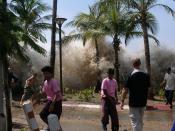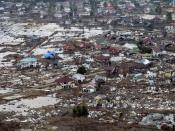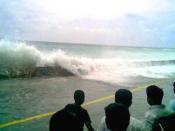At the close of the year 2004, at 7 a.m. on Dec.26, a megathrust quake 160 miles off the Sumatra coast sent 500-mph tsunamis out into the Indian Ocean. The waves hit the Sumatra province of Acch 15 minutes later, and in less than 7 hours it reached Africa, 3000 miles away. Little did Asia know that they were about to be hit by one of the worst Tsunami's to hit land in recorded history. A Tsunami, meaning wave in the harbor in Japanese, is a series of waves produced by one of 4 things: an earthquake, a landslide, a asteroid/meteor or a volcanic eruption. Most Tsunami's go undetected because they are only inched high. Others, like the one that was recently produced in the Indian Ocean, reached 30 feet. A Tsunami can be as long as one mile and can travel up to 1000 mph.
As a Tsunami reaches land, the water is sucked out into the ocean under the wave, which makes the wave grow in height. It then pounds whatever coast it is attacking. There are always more than one wave, and it is usually the 2nd or 3rd wave that causes most of the damage.
During the last week in December, two plates in the Indian Ocean shifted causing an earthquake measuring a 9.0 magnitude which is the largest earthquake ever recorded. The earthquake then triggered the Tsunami that traveled at speeds up to 500mph. There were multiple coasts that were affected including Thailand, Sri Lanka, India and Indonesia which was the hardest hit. The first coast to get hit was Sumatra which was hit in only 30 minutes without warning. The largest Tsunami ever recorded was in Lituya Bay Hawaii in 1958. The wave was triggered by a landslide in...


